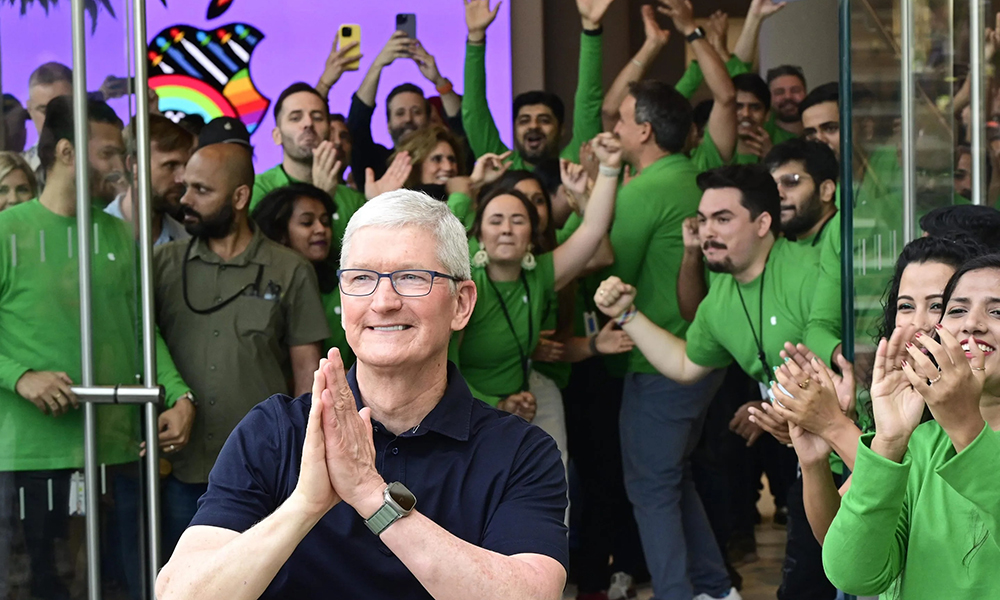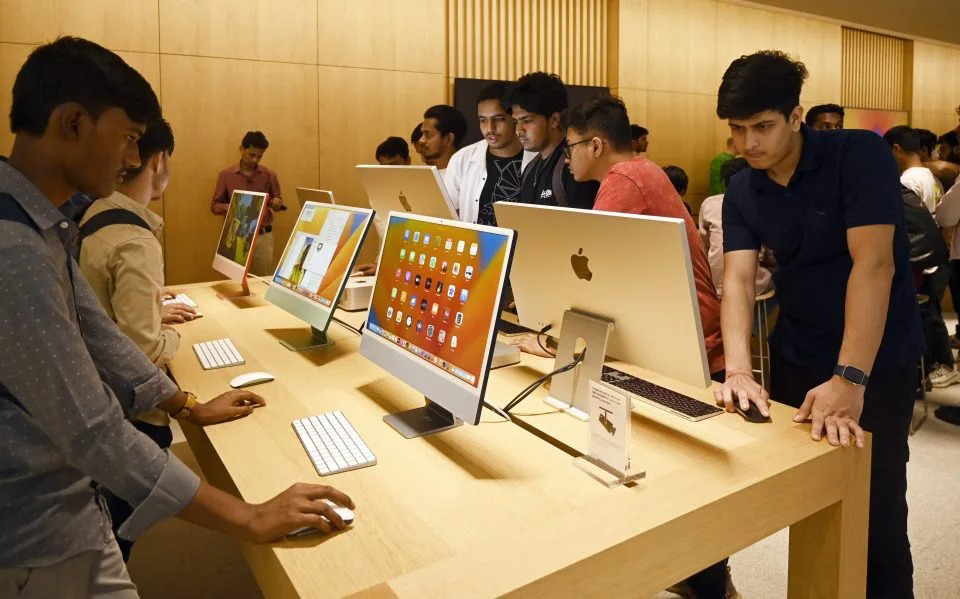
上周,苹果公司首家印度零售店在孟买开业,首席执行官蒂姆·库克参加了开幕仪式。库克发推特表示:“孟买的活力、创造力和热情令人难以置信!我们非常激动能在印度开设Apple BKC——我们在印度的第一家零售店。”
孟买的活力、创造力和热情令人难以置信!我们非常激动能在印度开设Apple BKC——我们在印度的第一家零售店。
——蒂姆·库克(@tim_cook),2023年4月18日
但这还不是全部。在接下来的几天里,库克会见了印度总理纳伦德拉·莫迪(Narendra Modi),以及宝莱坞明星和商界巨头,并了解了当地文化——这表明印度在苹果公司的扩张版图中越来越重要。
科技市场研究公司Counterpoint Research的数据显示,苹果公司6%的iPhone在印度生产。与中国(苹果公司的大部分产品都在中国生产)相比,这一数字显得微不足道。但这个数字正在迅速上升。据估计,印度目前每年生产1300万部iPhone,而三年前仅为500万部。随着印度在消费和生产方面的市场份额不断增长,苹果也在密切关注这一进展。
除了旗舰店之外,苹果公司正日益将目光投向印度。新冠肺炎疫情造成供应链中断,苹果公司试图减少对中国制造的依赖。在今年2月,苹果公司的第一季度财报电话会议上,库克表示,他“非常看好印度”,称这是一个“非常令人兴奋的市场”,是公司的“主要关注点”。
专家表示,由于当地有熟练的劳动力、庞大的智能手机市场,以及政府对制造业的支持,印度显然是开设新工厂的首选地。除了创造数十万个就业岗位外,苹果公司将目光投向印度,也推动了该国的经济发展(印度试图将自己定位为经济强国)。
科技投资公司Deepwater Asset Management的管理合伙人吉恩·蒙斯特(Gene Munster)在接受《财富》杂志采访时表示:“印度是全球增长潜力最大的地区,苹果公司进军印度市场是明智之举。”
印度成为制造业中心
20世纪90年代,在实施经济自由化政策之后,印度开始将自己定位为国际商业的目的地,使其成为全球IT服务外包的中心。
阿克伦大学(University of Akron)商学院副院长德玛丽娅·慕克吉(Debmalya Mukherjee)在接受《财富》杂志采访时表示:“随着时间的推移,西方企业意识到,它们本来追求的是降低成本,但它们最终留在那里是因为当地制造的产品品质卓越。”穆克吉的研究领域包括全球商业和印度等新兴经济体。
从国家层面来看,莫迪政府自2014年以来一直在推动“印度制造”运动,旨在促进当地的制造业发展,并创造就业岗位。生产挂钩激励计划(PLI)为电子和半导体等行业的制造商提供了财政奖励,以吸引国内外投资。其中一些政策对苹果公司有利。
Counterpoint Research高级分析师普拉奇尔·辛格(Prachir Singh)向《财富》杂志表示:“苹果公司在印度的三家制造合作伙伴——富士康(Foxconn)、纬创(Wistron)以及和硕(Pegatron)——都是生产挂钩激励计划的受益者。该计划是印度政府旨在促进当地电子制造业发展的刺激计划之一。”
疫情带来了改变,促使苹果等公司将印度视为主要制造业中心,这有助于促进印度制造业发展。苹果在2022年最后三个月的全球收入下降,这是自2019年以来的首次季度下降。包括越南在内的亚洲其他生产基地将受益于苹果公司寻求实现生产多元化。但作为世界上人口最多的国家,印度有着巨大的中等收入消费市场(这一市场仍有待苹果公司直接开发),进军印度市场有可能推动其实现增长。
蒙斯特说:“如果你是一家科技公司,这意味着你需要将增长纳入发展核心。为了实现增长,你必须追求更大的市场。放眼全球,印度市场潜力巨大,进军印度市场,科技公司就有望实现增长。”
去年9月,苹果公司宣布将在印度生产iPhone 14,自2017年以来,苹果一直在印度组装一些低端机型iPhone,包括iPhone SE和iPhone 12。摩根大通分析师预计,到2023年,苹果iPhone 14预计将有5%在印度生产,到2025年这一比例将攀升至25%。据报道,苹果的主要供应商之一富士康也考虑在印度南部扩张,以增加产能,满足在印度大规模生产iPhone的需求。
苹果公司没有立即答复《财富》杂志的置评请求。

智能手机难题
尽管印度在苹果供应链中的地位越来越重要,但短期内不会超过中国。
该品牌的绝大部分产品仍在中国生产。据《金融时报》报道,截至1月,超过95%的苹果顶级产品是在中国生产的。而印度巨大的制造业机会也伴随着系统性挑战。政策智库战略与国际研究中心(Center for Strategic and International Studies)印度问题主席理查德·罗索(Richard Rossow)表示,其中一些障碍包括无法在各州获得稳定的供应,如电力供应,以及长期悬而未决的劳工改革。
罗索说:“你并不一定会看到大量大型制造业投资者涌向印度。”
从消费者层面看,苹果公司产品仍被视为奢侈品。Counterpoint的数据显示,三星(Samsung)和小米(Xiaomi)等提供廉价替代品的品牌占据了印度智能手机市场近40%的份额,而苹果公司占据的市场份额仅为4%。
印度在允许苹果等公司直接向消费者销售产品方面一直进展缓慢。苹果进军印度市场的时间较晚,原因是印度的法规禁止外国公司在印度开设单一品牌的门店,除非产品中30%的原材料来自当地。相反,苹果不得不通过第三方在印度销售产品。但这一限制在2019年被放宽,为苹果公司在本周开设门店铺平了道路,此前该公司最初计划在2021年开设门店,但由于新冠肺炎疫情原因被推迟。
与一些亚洲国家相比,印度的智能手机渗透率相对较低,这表明苹果公司进军印度市场的时机已经成熟,尤其是在新兴的中上层阶级群体中。Counterpoint的数据显示,印度消费者选择以旧换新、分期和捆绑方式购买苹果产品,因为越来越多的人希望使用这一高端品牌的产品。
罗索说,苹果公司通过在印度开店获得了竞争优势,其他企业也可以效仿并从中获利。
罗索说:“你要么一马当先(在印度),引起轰动,然后开始学习如何在当地市场进行运营,要么等到当地市场已经非常完善了,但那时你可能会错失良机。”(财富中文网)
译者:中慧言-王芳
上周,苹果公司首家印度零售店在孟买开业,首席执行官蒂姆·库克参加了开幕仪式。库克发推特表示:“孟买的活力、创造力和热情令人难以置信!我们非常激动能在印度开设Apple BKC——我们在印度的第一家零售店。”
孟买的活力、创造力和热情令人难以置信!我们非常激动能在印度开设Apple BKC——我们在印度的第一家零售店。
——蒂姆·库克(@tim_cook),2023年4月18日
但这还不是全部。在接下来的几天里,库克会见了印度总理纳伦德拉·莫迪(Narendra Modi),以及宝莱坞明星和商界巨头,并了解了当地文化——这表明印度在苹果公司的扩张版图中越来越重要。
科技市场研究公司Counterpoint Research的数据显示,苹果公司6%的iPhone在印度生产。与中国(苹果公司的大部分产品都在中国生产)相比,这一数字显得微不足道。但这个数字正在迅速上升。据估计,印度目前每年生产1300万部iPhone,而三年前仅为500万部。随着印度在消费和生产方面的市场份额不断增长,苹果也在密切关注这一进展。
除了旗舰店之外,苹果公司正日益将目光投向印度。新冠肺炎疫情造成供应链中断,苹果公司试图减少对中国制造的依赖。在今年2月,苹果公司的第一季度财报电话会议上,库克表示,他“非常看好印度”,称这是一个“非常令人兴奋的市场”,是公司的“主要关注点”。
专家表示,由于当地有熟练的劳动力、庞大的智能手机市场,以及政府对制造业的支持,印度显然是开设新工厂的首选地。除了创造数十万个就业岗位外,苹果公司将目光投向印度,也推动了该国的经济发展(印度试图将自己定位为经济强国)。
科技投资公司Deepwater Asset Management的管理合伙人吉恩·蒙斯特(Gene Munster)在接受《财富》杂志采访时表示:“印度是全球增长潜力最大的地区,苹果公司进军印度市场是明智之举。”
印度成为制造业中心
20世纪90年代,在实施经济自由化政策之后,印度开始将自己定位为国际商业的目的地,使其成为全球IT服务外包的中心。
阿克伦大学(University of Akron)商学院副院长德玛丽娅·慕克吉(Debmalya Mukherjee)在接受《财富》杂志采访时表示:“随着时间的推移,西方企业意识到,它们本来追求的是降低成本,但它们最终留在那里是因为当地制造的产品品质卓越。”穆克吉的研究领域包括全球商业和印度等新兴经济体。
从国家层面来看,莫迪政府自2014年以来一直在推动“印度制造”运动,旨在促进当地的制造业发展,并创造就业岗位。生产挂钩激励计划(PLI)为电子和半导体等行业的制造商提供了财政奖励,以吸引国内外投资。其中一些政策对苹果公司有利。
Counterpoint Research高级分析师普拉奇尔·辛格(Prachir Singh)向《财富》杂志表示:“苹果公司在印度的三家制造合作伙伴——富士康(Foxconn)、纬创(Wistron)以及和硕(Pegatron)——都是生产挂钩激励计划的受益者。该计划是印度政府旨在促进当地电子制造业发展的刺激计划之一。”
疫情带来了改变,促使苹果等公司将印度视为主要制造业中心,这有助于促进印度制造业发展。苹果在2022年最后三个月的全球收入下降,这是自2019年以来的首次季度下降。包括越南在内的亚洲其他生产基地将受益于苹果公司寻求实现生产多元化。但作为世界上人口最多的国家,印度有着巨大的中等收入消费市场(这一市场仍有待苹果公司直接开发),进军印度市场有可能推动其实现增长。
蒙斯特说:“如果你是一家科技公司,这意味着你需要将增长纳入发展核心。为了实现增长,你必须追求更大的市场。放眼全球,印度市场潜力巨大,进军印度市场,科技公司就有望实现增长。”
去年9月,苹果公司宣布将在印度生产iPhone 14,自2017年以来,苹果一直在印度组装一些低端机型iPhone,包括iPhone SE和iPhone 12。摩根大通分析师预计,到2023年,苹果iPhone 14预计将有5%在印度生产,到2025年这一比例将攀升至25%。据报道,苹果的主要供应商之一富士康也考虑在印度南部扩张,以增加产能,满足在印度大规模生产iPhone的需求。
苹果公司没有立即答复《财富》杂志的置评请求。
智能手机难题
尽管印度在苹果供应链中的地位越来越重要,但短期内不会超过中国。
该品牌的绝大部分产品仍在中国生产。据《金融时报》报道,截至1月,超过95%的苹果顶级产品是在中国生产的。而印度巨大的制造业机会也伴随着系统性挑战。政策智库战略与国际研究中心(Center for Strategic and International Studies)印度问题主席理查德·罗索(Richard Rossow)表示,其中一些障碍包括无法在各州获得稳定的供应,如电力供应,以及长期悬而未决的劳工改革。
罗索说:“你并不一定会看到大量大型制造业投资者涌向印度。”
从消费者层面看,苹果公司产品仍被视为奢侈品。Counterpoint的数据显示,三星(Samsung)和小米(Xiaomi)等提供廉价替代品的品牌占据了印度智能手机市场近40%的份额,而苹果公司占据的市场份额仅为4%。
印度在允许苹果等公司直接向消费者销售产品方面一直进展缓慢。苹果进军印度市场的时间较晚,原因是印度的法规禁止外国公司在印度开设单一品牌的门店,除非产品中30%的原材料来自当地。相反,苹果不得不通过第三方在印度销售产品。但这一限制在2019年被放宽,为苹果公司在本周开设门店铺平了道路,此前该公司最初计划在2021年开设门店,但由于新冠肺炎疫情原因被推迟。
与一些亚洲国家相比,印度的智能手机渗透率相对较低,这表明苹果公司进军印度市场的时机已经成熟,尤其是在新兴的中上层阶级群体中。Counterpoint的数据显示,印度消费者选择以旧换新、分期和捆绑方式购买苹果产品,因为越来越多的人希望使用这一高端品牌的产品。
罗索说,苹果公司通过在印度开店获得了竞争优势,其他企业也可以效仿并从中获利。
罗索说:“你要么一马当先(在印度),引起轰动,然后开始学习如何在当地市场进行运营,要么等到当地市场已经非常完善了,但那时你可能会错失良机。”(财富中文网)
译者:中慧言-王芳
Apple CEO Tim Cook was in India this week to open the brand’s first flagship stores in the country. “The energy, creativity, and passion in Mumbai is incredible!” Cook tweeted. “We are so excited to open Apple BKC — our first store in India.”
The energy, creativity, and passion in Mumbai is incredible! We are so excited to open Apple BKC — our first store in India. pic.twitter.com/talx2ZQEMl
— Tim Cook (@tim_cook) April 18, 2023
But that wasn’t all. The Apple chief spent the next few days visiting Prime Minister Narendra Modi, meeting Bollywood stars and business magnates, and learning about the local culture—a sign of India’s increasing importance in Apple’s growth story.
India manufactures 6% of the iPhones—a miniscule number in comparison to China, where the bulk of Apple’s products are made, according to tech market research firm Counterpoint Research. But that number is rising rapidly. India is now making an estimated 13 million iPhones annually, compared to 5 million just three years ago. And as the country’s market share in the purchase and production fronts grow, Apple is paying attention.
Beyond its flagship store, Apple is increasingly looking towards India as it tries to reduce its manufacturing reliance on China following COVID-19-related supply chain disruptions and growing geopolitical tensions with Taiwan. During Apple’s first quarter earnings call in February, Cook said he was “very bullish on India,” calling it a “hugely exciting market” and “a major focus” for the company.
Experts say India was the obvious choice for new factories because of its skilled labor force, access to a big smartphone market, and government support for manufacturing. And apart from creating hundreds of thousands of jobs, Apple’s metaphorical spotlight on India is also boosting the country as it tries to position itself as an economic powerhouse.
“India has the greatest growth potential of any other region and that makes sense for Apple to go after,” Gene Munster, managing partner at Deepwater Asset Management, a tech-focused investment firm, told Fortune.
India as a manufacturing hub
India began positioning itself as a destination for international business in the 1990s, following economic liberalization policies, making it the global hub for outsourcing IT services.
“Western companies realized over time that they went for cost but they stayed there for quality,” Debmalya Mukherjee, associate dean at University of Akron’s business school, whose expertise includes global business and emerging economies like India, told Fortune.
At the national level, Modi’s government has been promoting his “Make in India” campaign since 2014, seeking to boost local manufacturing and create jobs. Production Linked Incentive (PLI) programs offer financial benefits to manufacturers in industries like electronics and semiconductors to attract domestic and foreign investments. And some of those policies have worked in Apple’s favor.
“All three manufacturing partners for Apple in India, Foxconn, Wistron, and Pegatron, are awardees of the PLI scheme which has been one of the top government schemes aimed at increasing manufacturing in India,” Prachir Singh, senior analyst at Counterpoint Research, told Fortune.
The pandemic also helped India by supercharging a shift for companies like Apple’s global revenue fell in the last three months of 2022 as a result—the first quarterly decline since 2019. Other production locations in Asia, including Vietnam, stand to benefit from Apple’s diversification from China. But India, the world’s most populous country, offered access to a tremendous middle-income consumer market that had not been directly tapped by Apple yet, and could potentially propel its growth.
“If you’re a tech company, which means that growth needs to be part of your DNA, in order to grow you have to go after big markets,” Munster said. “When you look at the world, the most juicy opportunity is India to drive that growth.”
Last September, Apple announced that it would make iPhone 14 in India, where it had been assembling some of its earlier models since 2017, including the iPhone SE and iPhone 12. In 2023, 5% of Apple’s iPhone 14 are projected to be made in India, climbing to 25% by 2025, according to JPMorgan analysts. One of Apple’s major suppliers, Foxconn, is also reportedly eyeing an expansion in southern India as part of this push.
Apple did not immediately return Fortune’s request for comment.
The smartphone conundrum
Despite India’s growing prominence in Apple’s supply chain, it’s not going to outshine China anytime soon.
China still controls the lion’s share of the brand’s products. As of January, more than 95% of Apple’s top products were manufactured in China, the Financial Times reported. And India’s massive manufacturing opportunity also comes with systemic challenges. Some of the hurdles include steady access to utilities like electricity provided by individual states and long-pending labor reforms, according to Richard Rossow, the India chair at the Center for Strategic and International Studies, a policy think tank.
“You still don’t necessarily see massive waves of the big manufacturing investors flocking to India,” Rossow said.
On the consumer end, Apple products are still considered a luxury item. Brands offering cheaper alternatives including Samsung and Xiaomi capture nearly 40% of India’s smartphone market share compared to Apple’s 4%, according to Counterpoint.
India has also been slow to change its rules to allow companies like Apple to sell their products directly to consumers. Apple’s late retail foray into India was due to regulations that prevented foreign companies from opening single-brand stores in India unless 30% of the raw materials that go into the product were sourced locally. Instead, Apple had to sell its products in India through third parties. But that restriction was eased in 2019, paving way for Apple to finally open a store this week after its initial plan to do so in 2021 was delayed because of COVID-19.
The country’s relatively low rate of smartphone usage compared to some Asian peers suggests that India is ripe with opportunities for the iPhone-maker, particularly among the burgeoning upper middle class segment. Indian customers are opting for trade-in, financing and bundling schemes to purchase Apple’s products as more of them want to be associated with the premium brand, according to Counterpoint.
Apple has already gained an edge against rivals by setting up shop in India—a move that other businesses could also follow and profit from, according to Rossow.
“Either you go there [India], you make a big splash and you start learning how to operate in the market, or you wait till it’s perfect, and at which time you probably missed the bus,” Rossow said.






